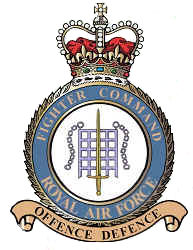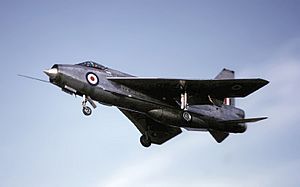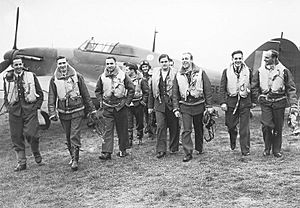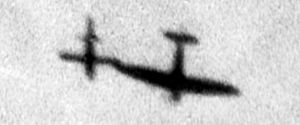RAF Fighter Command facts for kids
Quick facts for kids Fighter Command |
|
|---|---|

RAF Fighter Command badge
|
|
| Active | 14 July 1936–1968 |
| Country | |
| Branch | |
| Garrison/HQ | RAF Bentley Priory |
| Motto(s) | Offence Defence |
| March | Fighter Command March |
| Engagements | World War II Cold War |
| Commanders | |
| Notable commanders |
Sir Hugh Dowding Sir Sholto Douglas |
| Aircraft flown | |
| Fighter | Hawker Hurricane Supermarine Spitfire Gloster Meteor Hawker Hunter English Electric Lightning |
RAF Fighter Command was a very important part of the Royal Air Force. It was created in 1936 to better control fighter aircraft. These are planes designed to shoot down other planes. Fighter Command played a huge role throughout World War II. It became famous during the Battle of Britain in 1940. During this battle, a small group of pilots, known as the Few, bravely defended Britain from attacks by the German air force, the Luftwaffe.
Fighter Command was temporarily split up in 1943. Its defensive role became Air Defence of Great Britain (ADGB). Its attacking role became the RAF Second Tactical Air Force. But ADGB was renamed Fighter Command again in 1944. It continued to protect Britain. The command finally closed down in 1968. It became part of the new Strike Command.
Contents
How Fighter Command Started
Fighter Command began as a smaller unit called "Fighting Area" in 1926. It was part of the Air Defence of Great Britain. In 1932, Fighting Area became a full "Command." Then, on May 1, 1936, it was officially named Fighter Command.
In 1940, a special group, No. 60 Group RAF, was added to Fighter Command. This group was in charge of the Chain Home radar system. Radar was a new technology that helped detect enemy planes.
Fighter Command in World War II
The Battle of Britain
Before World War II, Fighter Command grew a lot. It replaced older planes like biplanes with two famous aircraft. These were the Hawker Hurricane and the Supermarine Spitfire. These planes were much faster and more powerful.
The biggest challenge for Fighter Command came in the summer of 1940. This was during the Battle of Britain. The German Luftwaffe launched a huge attack. Their goal was to control the skies over the English Channel and the United Kingdom. This was a necessary step before they could invade Britain by sea.
Fighter Command divided Britain into different areas, each defended by a "Group."
- 11 Group defended southeast England and London. It faced the main German attacks.
- 10 Group covered southwest England.
- 12 Group protected the Midlands and East Anglia.
- 13 Group looked after the North of England and Scotland.
- 60 Group managed the important radar stations.
In the end, Germany failed to gain control of the air. Both the RAF and the Luftwaffe lost many planes. But Britain's defense held strong.
The 1941 Air Offensive
By May 1941, Fighter Command began to attack German forces. They sent large groups of Spitfires, sometimes with a few bombers. The goal was to draw German fighters into battle. This kept German planes busy in the west. It was especially important after Germany attacked the Soviet Union in June 1941.
However, the Spitfire had a limited range. This meant British pilots could become prisoner of war if shot down over France. Fighter Command claimed to have shot down many German planes. But the actual German losses were much lower. The RAF lost more fighters than the Germans did.
Later in 1941, a new German plane appeared: the Focke-Wulf Fw 190. This plane was better than the Spitfire Mk V. This put British fighters at a disadvantage.
Meanwhile, Germany continued to bomb British cities. This was known as the Blitz. Fighter Command's night defenses got much better. They used new planes like the Bristol Beaufighter. These planes had improved Airborne Interception radar. More anti-aircraft guns also got radar. This made them more accurate. German bomber losses increased. The Blitz ended in May 1941 when Germany moved its bombers to fight in Eastern Europe.
1942–1945: Continued Battles
The tough fight against Germany continued into 1942 and 1943. Fighter squadrons also flew many defensive patrols. Small groups of Fw 190s would fly quick "hit and run" raids along the south coast. The new Hawker Typhoon plane also joined the RAF.
On August 19, 1942, during the Dieppe Raid, the RAF fought many German planes. Spitfire squadrons flew missions to attack ground targets, escort bombers, and fight enemy planes. They stopped the Luftwaffe from interfering with the battle on the ground and sea.
In 1942, Fighter Command claimed many victories. But they also lost many of their own planes.
By late 1942, the United States Army Air Forces (USAAF) 8th Air Force arrived. They brought daylight bombers. Fighter Command's job now included protecting these bombers. Until American fighters like the Republic P-47 Thunderbolt were ready, Spitfires protected the Boeing B-17 Flying Fortresses and Consolidated B-24 Liberators. However, the Spitfire's limited range meant it could only protect them over the Channel and near the European coast.
In 1943, Fighter Command was split. The Air Defence of Great Britain (ADGB) defended Britain. The RAF Second Tactical Air Force supported ground forces after the invasion of Europe.
In 1944, ADGB (which was renamed Fighter Command again in October 1944) played a huge role in Operation Overlord. This was the invasion of France. RAF and Allied fighters stopped German air attacks. They also helped ground forces by attacking German positions. Later in the war, Fighter Command faced the V-1 flying bombs during Operation Crossbow. RAF fighters also flew night missions to attack German airfields.
From 1939 to 1945, RAF Fighter Command lost many brave people and planes.
The Royal Observer Corps
The Royal Observer Corps (ROC) was a group of volunteers who helped Fighter Command. They watched for enemy aircraft. Because of their important work during the Battle of Britain, King George VI gave them the title "Royal." From 1941, they became a uniformed volunteer part of the RAF.
The ROC headquarters was at RAF Bentley Priory. They remained under Fighter Command until 1968. Then, they moved under the new RAF Strike Command.
The ROC was a defense warning group in the United Kingdom. It operated from 1925 to 1995. At first, they identified and reported aircraft. Later, during the Cold War, they switched to reporting nuclear attacks.
The Cold War Years

After World War II, Fighter Command's job was still to protect the UK from air attacks. But now the threat was from the Soviet Union. During the Cold War, there was a big worry about Soviet bombers attacking Britain. These bombers could carry nuclear weapons. So, stopping them was very important.
Many different fighter planes served with Fighter Command in the 1950s and 1960s. Some important ones were the Gloster Meteor, Hawker Hunter, Gloster Javelin, and the English Electric Lightning.
The Lightning was the only British supersonic plane to enter service. This was partly because of a big defense review in 1957. At that time, new surface-to-air missiles were getting very good. The government thought these missiles would soon be able to shoot down any manned aircraft. So, they decided to cancel many plans for new manned aircraft. The Lightning was too far along in its development to be cancelled. This decision, along with the high costs of developing planes, made the RAF rely on foreign or jointly developed aircraft.
In 1961, RAF Fighter Command became part of NATO's air defense system.
Joining Strike Command
In the 1960s, the RAF became smaller. Fighter Command, Bomber Command, and Coastal Command had all been formed in 1936. They were created to manage a growing RAF. But now, the RAF was becoming too small to have them as separate commands.
So, in 1968, Fighter Command and Bomber Command joined together. They formed Strike Command. Both became groups within this new command. Coastal Command also joined Strike Command in 1969.
Leaders of Fighter Command
| From | To | Name |
|---|---|---|
| 14 July 1936 | 25 November 1940 | Air Chief Marshal Sir Hugh Dowding |
| 25 November 1940 | 28 November 1942 | MRAF Sir Sholto Douglas |
| 28 November 1942 | 15 November 1943 | Air Chief Marshal Sir Trafford Leigh-Mallory |
| 15 November 1943 | 14 May 1945 | Air Chief Marshal Sir Roderic Hill |
| 14 May 1945 | 17 November 1947 | Air Chief Marshal Sir James Robb |
| 17 November 1947 | 19 April 1949 | Air Chief Marshal Sir William Elliot |
| 19 April 1949 | 7 April 1953 | Air Chief Marshal Sir Basil Embry |
| 7 April 1953 | 1 January 1956 | MRAF Sir Dermot Boyle |
| 1 January 1956 | 8 August 1956 | Air Chief Marshal Sir Hubert Patch |
| 8 August 1956 | 30 July 1959 | MRAF Sir Thomas Pike |
| 30 July 1959 | 18 May 1962 | Air Marshal Sir Hector McGregor |
| 18 May 1962 | 3 March 1966 | Air Marshal Sir Douglas Morris |
| 3 March 1966 | 30 April 1968 | Air Chief Marshal Sir Frederick Rosier |
Images for kids
-
The supersonic fighter English Electric Lightning, a mainstay of Fighter Command during the Cold War years.
See also
- List of Royal Air Force commands






